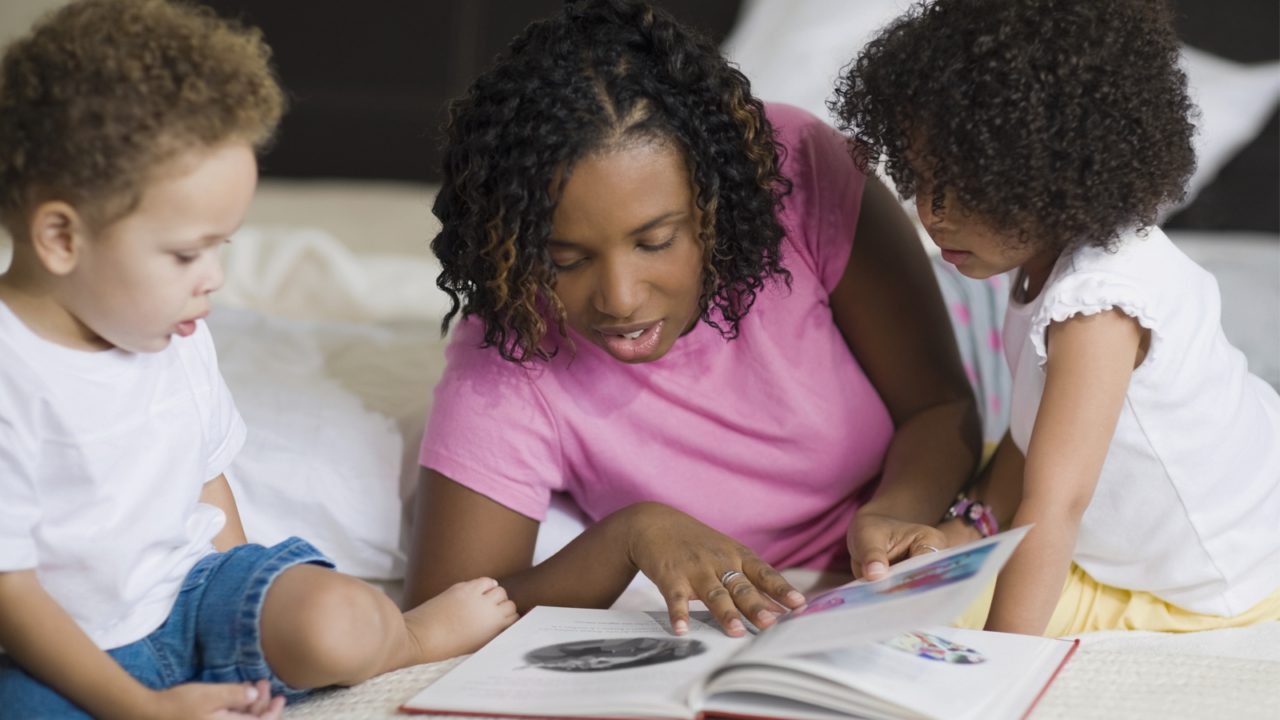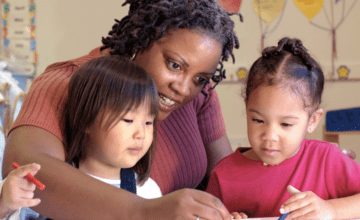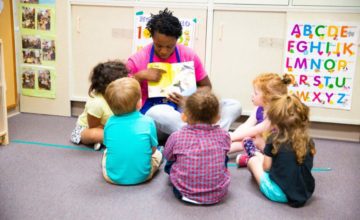Strong preferences for one parent or caregiver over another are really common, especially around this age. Browse the information and links below to see what your little one is experiencing and learning this month.
IN THIS RESOURCE
- What It’s Like for You
- What It’s Like for Your Child
- What to Expect From Your Toddler’s Development
- Did You Know…
- Spotlight on: Making Your Home the Imagination Station
- Let’s Play: Activities That Nurture Bonding and Learning
- What’s on Your Mind?
- Expert Reviewers
What It’s Like for You
Says Sylvia, mother of Meredith, age 25 months:
For the first 2 years of Meredith’s life, I was the center of her world. Then, right around the time she turned 2, she became “Daddy’s Little Girl.” Now it’s got to be Daddy who puts her shoes on, gives her bath, gets up with her in the morning. On the one hand, it’s kind of nice to have a break. But—and I know this probably sounds silly—I am pretty hurt by it too. Meredith will stand there screaming at the top of her lungs: No Mommy! No Mommy! Want Daddy! How do I not take that personally?
Strong preferences for one parent or caregiver over another are really common, especially around this age. Often, like Meredith above, a toddler will switch her “favorite” from the person who had been the primary caregiver in her babyhood to another loved adult. Sometimes, “favorites” last only a short time—a child may demand that only Mommy put her sneakers on and then just a little while later, only Papa can zip her jacket. For many toddlers, this is about expressing preferences and learning to make choices. It might also be a way that your “big kid” is showing that she is separate and independent from you. Sometimes the switch from one parent to another can be practical. For example, if Mom is pregnant, a toddler may sense that Dad has more energy for him and naturally comes to depend on him more heavily.
While it can be upsetting and disappointing to no longer be treated as “number one,” rest assured this doesn’t mean that your child loves you less. It is likely because she is so secure with you that she feels safe enough to separate from you, since she knows you’ll always be there for her no matter what.
To help your toddler through this stage, avoid showing any negative (hurt, angry, frustrated) emotions when your child insists that her current “favorite” put her to bed. Instead, when it is possible and reasonable, give your child permission to make some choices about who takes care of her daily routines like bathing, going to bed, and getting dressed. Ask if she wants Daddy or Mommy to read her a story at bedtime. This sense of independence (within limits) helps to ease your child’s growing pains between baby and toddler and lets her know that all of you are on the same team.
What It’s Like for Your Child
Daddy gave me some mashed potato to eat. He said it was yummy. I tried a little on my tongue. Ewww, it was so mushy. It was really yucky in my mouth. I didn’t like the way it felt, all soft and globby on my tongue. YUCK. I spit it out. Eccch! No like that! I said. Daddy looked at me: You don’t like the potatoes? Is something wrong with them? He took a taste from my spoon. It tastes good to me. Here, have another try. He put the spoon to my mouth and I tasted it again. Ewww, it’s too mushy! I spit it out again and gagged this time. I started to cry. I wonder what’s wrong, Dad said. He brushed my check with his fingers and gave me a kiss on my head. Sorry, little man. This mashed potato thing is just not agreeing with you. Why don’t you eat some meat and I’ll figure something out. He came back with a boiled potato. Here’s a potato I didn’t mash. Let’s see if you like that better. He cut it into chunks. I picked up a piece and put it in my mouth. Yummmm. That’s much better. It’s not mushy at all. More! I said. I picked up another piece and popped it in my mouth. Dad said, Look at that smile! I think boiled potatoes are the winner! Then he helped me count all the pieces I popped into my mouth. We got all the way up to five!
What Your Toddler Is Learning
Social-Emotional Skills:
- Trust in his father (and adaptability) when he gives the mashed potatoes a second try at his dad’s coaxing.
- Confidence that he is an effective communicator as he uses gestures and words to express his feelings about the mashed potatoes.
- Persistence, as he tries the potatoes several times and in different forms (mashed vs. boiled).
Language and Thinking Skills:
- Good communication skills as he uses gestures and language to communicate his thoughts and feelings.
- Numbers and counting as he and dad count the pieces of potato he eats.
Physical Skills:
- Development of his fine motor skills (using the small muscles in his hands and fingers) as he lifts the spoon to his mouth and feeds himself chunks of potato. These muscles will be critical for learning how to write when he is a little bigger.
- Sensory awareness—that is, recognizing the difference in texture between mashed and boiled potato.
What to Expect From Your Toddler’s Development
As you read the chart below, keep in mind that development is not a race and that every child grows at her own pace and in her own way. Your child may develop skills faster or slower than indicated below and still be on track. If you have questions or concerns, talk with your child’s health care provider or other trusted professional.
Your Toddler’s Development From 24 to 30 Months
| What Your Baby Can Do | What You Can Do to Connect With Your Baby |
|---|---|
I use my body to get me places! |
|
|
|
I am using language to tell you what I’m feeling and thinking. |
|
|
|
I am getting really good at playing pretend. |
|
|
|
I want to make friends but still need help with sharing. |
|
|
|
Did You Know…
Your child is learning a lot from her picture books? Researchers read two groups of young children—18-month-olds and 2-year-olds—picture books that showed a child making a simple rattle in three steps. Two types of books were used, one with color photos and one with colored pencil drawings. After reading the story, the children were given the objects they saw in the picture books and were asked to make a rattle. Two-year-olds were able to remember and copy many of the actions they had seen in the books (as compared to 18-month-olds who had much more difficulty). And children did much better copying the actions they had seen in the books with color photos versus pencil drawings.
What the Research Means for You
When choosing books for your toddler, be sure to include some with photos or realistic pictures of common objects that your child sees in her daily life. As you read these stories together, repeat the names of these objects in the book and then find them in your home or neighborhood. This helps your child build the connection between the idea of something (in the book) and the object in “real life.” It also builds her vocabulary. Consider making photo books of your child performing daily tasks, like getting ready for bed (photos of bath, getting pajamas on, tooth-brushing, etc). This helps your child see the order of daily events. Sequencing is an important literacy skill and will also help your child begin to understand and anticipate daily routines.
Spotlight on: Making Your Home the Imagination Station
Babies are born learners, with a natural curiosity to figure out how the world works. In the toddler years, you will see your child’s curiosity spur her imagination. For example, a 2-year-old has been watching the waitress that she sees at the diner where she eats with her family every Sunday. When she gets home, she sets out toy plates and cups on the sofa. She even takes some paper napkins from the kitchen to put these on her “table.” She is curious about imitating all the actions she has seen “real” waitresses perform. This is the beginning of using her imagination in her play—otherwise known as pretend play—a very powerful vehicle for thinking through new ideas and “testing” them out.
Below are some ways to nurture your child’s imagination and learning:
- Let your child explore interesting “stuff.” Unlike some toys that are designed to be used a certain way, materials like boxes, blocks, water, sand, pots, and pans, and any art materials, can be used imaginatively. No need to tell your child what to do with the material or what the finished product should look. Let your child’s curiosity and imagination be her guide.
- Follow your child’s lead. Encourage your child’s interests. Your child learns best through activities that capture his attention and imagination. If your toddler likes music, play it for him often, make and play instruments and dance together. If bugs are his thing, give him a shovel and a net. Find books on bugs. And show your own interest in the world around you. You are your child’s role model for being an eager, curious learner.
- Use your community’s resources. Take a “field trip” together to the public library and let your toddler choose a book to borrow. You can also check into community-run classes, local nature centers, or parent-child drop-in centers. Many of these activities are low-cost or free of charge and can open up new worlds to your child.
- Stimulate your child with open-ended questions. While your child won’t be able to answer Why or What do you think questions at age 2, it’s good to get in the habit of asking. Open-ended questions are ones that don’t have a clear-cut right or wrong answer, such as: “How do you feel about…..”; “What was (such and such experience) like for you?”; “Why do you think (such and such) happened?”; “Tell me about your favorite part of the book.” These kinds of questions encourage your child to develop her own thoughts and ideas. They also give you a window into her inner life—what she’s curious about, thinking through, or coping with. Asking your child questions, and listening to the answers, tells her that her ideas are important to you.
- Create an interesting environment. Hang photos of your child’s artwork at his level. Put some music on while he plays. Give him fun “props” that he can use to act out stories—old towels become superhero capes, a worn-out t-shirt can make him a ghost, a plastic bowl turns into an astronaut helmet. Throw a blanket over a low table and you’ve made a cave, a house, or a barn. Keep your child’s pretend play props in a cardboard “trunk” that the two of you decorate with paint, markers, and glitter. Redirect, don’t discourage. Try to figure out what is capturing your toddler’s interest, or what skill she is trying to master, and create a safe and acceptable way for her to explore. For example, if your toddler loves messing around with the house plants, put them out of reach but offer a close alternative. You might put some dirt in a plastic container for your child to play with and inspect outdoors. If she likes to pour the water from her cup onto the high chair or floor, move her to the bathtub or backyard so she can explore and experiment with water without making extra work for you.
- Tell stories. As you take a walk together, talk about the ants you see crawling on the ground or the squirrels you see scurry up the trees. Make up simple stories about where the city bus goes or the adventures of the bulldozer you see at a construction site.
- Make art and music part of your child’s life. Play different types of music—classical, rock, bluegrass, zydeco, rap, gospel, Motown—and see which kind he likes best. Make music with your child using homemade “kitchen” instrument—an empty oatmeal canister can be a drum if you give your child a wooden spoon to bang on top. Be creative about art materials. Let your child scribble with markers, or glue leaves or sticks to paper for a nature collage. He can even roll his favorite toy truck through washable paint and then over a piece of paper you’ve taped to the table. Encouraging your child to be imaginative with art materials builds his creativity, problem-solving, and fine motor skills (using small muscles in his hands and fingers).
Let’s Play: Activities That Nurture Bonding and Learning
Ring-a-Ling
Using a long length of string, hang a bell or a rattle from a low tree branch or a doorframe. Give your child a foam bat or wooden spoon and let her hit the rattle or bell and make a sound. Games like this build hand-eye coordination and muscle strength in your child’s arms and shoulders. (Be sure to supervise carefully and put the string away when you are done playing.)
Macaroni Matches
Lay a variety of pasta shapes out on the table (making sure there are matches for each). Pick up a piece of pasta and ask your child, Do you see a match for this? Is there another one that looks just like it? Together with your child, match the remaining pasta pieces. If you’d like, you can allow your child to dip each pasta piece in some glue and then place on a sheet of heavy paper to make his own “macaroni art.”
What’s on Your Mind?
1. My 2-year-old is pretty physical—he will slap his sister if he gets angry or grab toys out of her hands. I never saw this behavior in my daughter (who’s now 5). How should I handle it?
That’s the beauty, and challenge, of having multiple children—no two are the same. The behavior you describe is actually very common at this age, especially for children who are feisty and physical like your son. Why? Two-year-olds do not yet have the impulse control necessary to stop themselves from going for something they desire, even if they have been told countless times to “be gentle” or “take turns.” In addition, most don’t yet have the language skills to verbally express their thoughts and feelings, so their primary means of communication is through their actions. The fact that your son is physical means he is also more likely to use his body to express himself.
The good news is there is a lot you can do to help your son learn to communicate and meet his needs without being hurtful to others:
- Practice prevention. When you see your son in a situation in which he is likely to feel angry or frustrated, try to head it off. If he is eyeing a toy your daughter is playing with, acknowledge that he might like to play with that toy too, but that he has to wait his turn. Then help him choose another toy.
- Validate his feelings. Get down on your child’s eye level and firmly, but not angrily, let him know: It’s okay to get angry. Everyone gets angry. * * Try your best to show as little emotion as possible. The more intense your reaction, the more intensely he is likely to respond.
- Set the limit. It’s not okay to hit or grab. It is a rule in our family that we can’t hurt others. Help him give the toy back and choose another one.
- Suggest other ways to express anger that are acceptable to you. He might draw out his anger with a red crayon, stomp his feet as hard as he can, or bang on a pillow. The idea is to teach him ways to express anger and frustration in ways that are not hurtful to himself or others.
- Practice sharing. Get a kitchen or other timer and set it for the amount of time each child has to wait his or her turn. This can be a very useful tool for helping children learn to wait as it gives them a more tangible sense of time passing.
The combination of your son developing more language and your consistent limits and guidance will help him learn to manage his emotions and cope with the challenge of sharing as he grows.
2. My 2-year-old twins are starting child care. The center is letting me choose whether they should be placed in the same classroom or not. They are each other’s best friend, and tend to only play with one another at playgroups. I want them to make friends of their own. Should we have them placed in the same classroom or not?
How wonderful for you and your children. Most parents struggle with how to keep their kids from constantly fighting. The idea that they could be best friends often feels like a faraway dream!
You do raise an important question for the growing number of parents with twins—though there is not a clear-cut right or wrong answer. Like most parenting dilemmas, there are pros and cons to most decisions. The one you pose is no exception. As you point out, the pros of having your children in separate classes is that they may be more likely to branch out and make new friends. This can be a very important benefit of being in child care. And as they grow, it is certainly helpful for twins to have opportunities to separate and function independently from one other. This means learning how to form friendships and cope in new situations without depending on their twin to always be there.
At the same time, this is a big change for them to go from being together all day to being apart for a large chunk of time. In addition, the transition to child care in and of itself is a major change that some children find scary and overwhelming. Having to deal with separating from their twin for the first time and adjusting to the new child care setting is a lot to handle.
The benefit of keeping your children together is that they will have the support and familiarity of having someone they know and love with them in this new setting, which can make the transition much easier. At the same time, being in child care will significantly expand your children’s worlds. They will be exposed to all sorts of new activities and people to engage with that will help them learn to separate gradually over time. You can talk with the teachers about helping your children begin to branch out and develop new friendships. For example, when they see your children playing exclusively together, the teachers can invite other children to join in. This will help your twins to gradually form relationships with their classmates. As the year progresses, you can also ask the teachers to place your children in separate groups when they divide the class up for activities.
Being a twin is special. It means that you always have someone there for you, for better or worse. So while they will quite naturally begin developing new friends, and learn to function independently, if your twins remain one another’s best friend all their lives—well, that is quite a gift.
Expert Reviewers
- Terrie Rose, PhD, President and Founder, Baby’s Space
- Ross Thompson, PhD, Professor of Psychology, University of California at Davis
- Robert Weigand, MS, IMH-E, Director, Child Development Laboratory, Arizona State University




